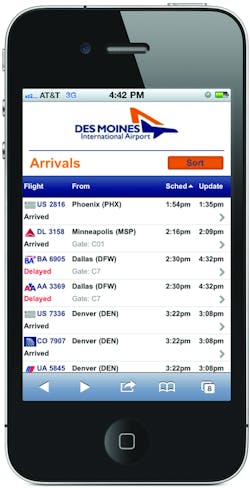FlightView Inc. has been developing flight tracking tools for general and commercial aviation for some 30 years, and the company is now a leading developer of mobile technologies for the aviation industry.
According to a recent survey of FlightView airport customers, when asked what the important specific priorities for 2011 were, improving customer service, providing valuable and timely travel information, and revenue growth were identified as key issues. FlightView also surveyed travelers on their expectations for mobile technology ... for airports, 62 percent of travelers prefer to check their flight status on mobile websites; only 38 percent prefered mobile native apps, and 65 percent said having an airport mobile-ready website was of high importance.
With airports in the U.S. taking on an increasing role in customer service, and mobile technologies becoming prevalent among frequent flyers, airports are faced with a challenge: what is the best way for an airport to deliver critical real-time travel information to passengers frequenting airport terminal facilities?
Comments FlightView CEO Mike Benjamin, "More people are relying on mobile technology on the day of travel than ever before.
"We are all about providing day-of-travel information, the theory being, a well-informed traveler is a happy traveler. Part of what has been exciting for us is riding some of the different technology waves, and mobile is the latest ... it's a great way to deliver flight information."
Apps vs. mobile websites
Asks Benjamin, "As an airport, what is the best bang for the buck in this mobile space?
"We think it is in developing a mobile-enabled website; a site that detects what kind of phone it’s being viewed on and takes advantage of the full-screen real estate and how the user-interface works."
The other alternative is in developing a mobile app (application), relates Benjamin, which he explains is better for an airline because it can take advantage of storing frequent flyer numbers, and integrating the app with a smart phone's address book.
"The problem with an app is you have to make one for each mobile platform, whether it be iPhone, Android, or Blackberry," adds Benjamin.
An app has codes that reside on a phone, so it can take advantage of storing certain data; a mobile website typically can’t do that, he explains.
Flightview has developed apps for all of the major mobile platforms. The apps give more of a personalized tool for the travel journey, whereas the mobile website is somewhat more general and simplified, but able to deliver critical information in real-time on a simple user interface.
"An airport mobile-enabled site is really great for airport specific information that would be harder to get into an app, such as information about a closed parking garage or a gate change," remarks Benjamin.
"There are airports where an app can make sense, but they would be those large airports with expansive retail spaces."
Site development
"The thing about a mobile site compared with a regular website is you really have to think about the people using it; they are on the go," explains Benjamin. "You really want to keep the user interface simple: arrivals, departures, amenities; don’t give people a lot of choices. You want big buttons on a simplified interface."
Flightview also thinks a lot about how users filter and sort airport-related travel information. Says Benjamin, "So if you have a large airport with a list of hundreds of flights ... how do you filter that so the user can quickly and easily find specific information about a particular flight.
"People are also often interested in the next flight, or a connecting flight ... so we give them the opportunity to do what we call a ‘city-pair’ search or a flight number search."
Weather is also information that travelers are interested in accessing easily; both weather forecasts of the current location as well as the ultimate destination. The company can also display a weather radar to give users an idea of what the aircraft is going to have to deal with during the journey.
Including wayfinding information and terminal maps is also very important, says Benjamin.
From a revenue standpoint, there is opportunity within a mobile-enabled website to give terminal retailers and food vendors a space to advertise in, he adds.
The future
"We think that this information is going to be ubiquitous, and the keys are being accurate and consistent with the data, so people get the same information, and most importantly, they can act on that information," comments Benjamin.
"Mobile devices will become more and more where you expect to get this type of information."
Emerging features include alerting functions, so that if a gate changes the phone will inform the passenger before they hear it from the airline gate counter.
One thing to remember in terms of O&M, remarks Benjamin, "You can bet is there is going to be a lot of changes in the future, and new functionality; think about the maintenance end of it."
Flightview maintains ongoing service contracts with its airport customers at a monthly rate, he relates. The company's latest mobile website launch was for the Des Moines International Airport; the site took three months to develop.



